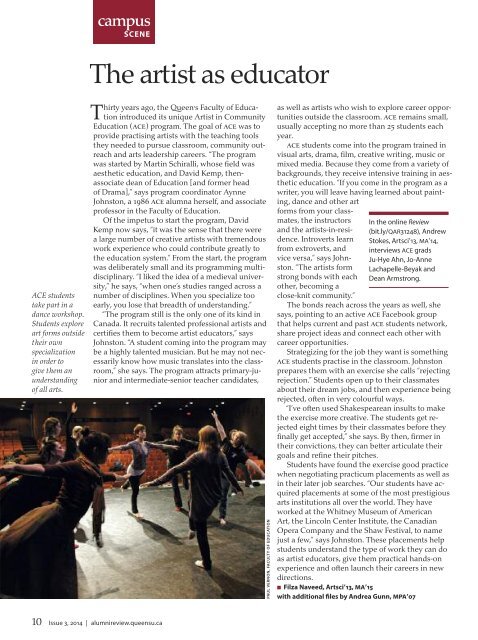AlumniReview32014_0
AlumniReview32014_0
AlumniReview32014_0
Create successful ePaper yourself
Turn your PDF publications into a flip-book with our unique Google optimized e-Paper software.
ACE students<br />
take part in a<br />
dance workshop.<br />
Students explore<br />
art forms outside<br />
their own<br />
specialization<br />
in order to<br />
give them an<br />
understanding<br />
of all arts.<br />
campus<br />
sCene<br />
The artist as educator<br />
Thirty years ago, the Queen’s Faculty of Education<br />
introduced its unique Artist in Community<br />
Education (ace) program. The goal of ace was to<br />
provide practising artists with the teaching tools<br />
they needed to pursue classroom, community outreach<br />
and arts leadership careers. “The program<br />
was started by Martin Schiralli, whose field was<br />
aesthetic education, and David Kemp, thenassociate<br />
dean of Education [and former head<br />
of Drama],” says program coordinator Aynne<br />
Johnston, a 1986 ace alumna herself, and associate<br />
professor in the Faculty of Education.<br />
Of the impetus to start the program, David<br />
Kemp now says, “it was the sense that there were<br />
a large number of creative artists with tremendous<br />
work experience who could contribute greatly to<br />
the education system.” From the start, the program<br />
was deliberately small and its programming multidisciplinary.<br />
“I liked the idea of a medieval university,”<br />
he says, “when one’s studies ranged across a<br />
number of disciplines. When you specialize too<br />
early, you lose that breadth of understanding.”<br />
“The program still is the only one of its kind in<br />
Canada. It recruits talented professional artists and<br />
certifies them to become artist educators,” says<br />
Johnston. “A student coming into the program may<br />
be a highly talented musician. But he may not necessarily<br />
know how music translates into the classroom,”<br />
she says. The program attracts primary-junior<br />
and intermediate-senior teacher candidates,<br />
PAUL VERNON, FACULTY OF EDUCATION<br />
as well as artists who wish to explore career opportunities<br />
outside the classroom. ace remains small,<br />
usually accepting no more than 25 students each<br />
year.<br />
ace students come into the program trained in<br />
visual arts, drama, film, creative writing, music or<br />
mixed media. Because they come from a variety of<br />
backgrounds, they receive intensive training in aesthetic<br />
education. “If you come in the program as a<br />
writer, you will leave having learned about painting,<br />
dance and other art<br />
forms from your classmates,<br />
the instructors<br />
and the artists-in-residence.<br />
Introverts learn<br />
from extroverts, and<br />
vice versa,” says Johnston.<br />
“The artists form<br />
strong bonds with each<br />
other, becoming a<br />
close-knit community.”<br />
In the online Review<br />
(bit.ly/QAR31248), Andrew<br />
Stokes, Artsci’13, MA’14,<br />
interviews ACE grads<br />
Ju-Hye Ahn, Jo-Anne<br />
Lachapelle-Beyak and<br />
Dean Armstrong.<br />
The bonds reach across the years as well, she<br />
says, pointing to an active ace Facebook group<br />
that helps current and past ace students network,<br />
share project ideas and connect each other with<br />
career opportunities.<br />
Strategizing for the job they want is something<br />
ace students practise in the classroom. Johnston<br />
prepares them with an exercise she calls “rejecting<br />
rejection.” Students open up to their classmates<br />
about their dream jobs, and then experience being<br />
rejected, often in very colourful ways.<br />
“I’ve often used Shakespearean insults to make<br />
the exercise more creative. The students get rejected<br />
eight times by their classmates before they<br />
finally get accepted,” she says. By then, firmer in<br />
their convictions, they can better articulate their<br />
goals and refine their pitches.<br />
Students have found the exercise good practice<br />
when negotiating practicum placements as well as<br />
in their later job searches. “Our students have acquired<br />
placements at some of the most prestigious<br />
arts institutions all over the world. They have<br />
worked at the Whitney Museum of American<br />
Art, the Lincoln Center Institute, the Canadian<br />
Opera Company and the Shaw Festival, to name<br />
just a few,” says Johnston. These placements help<br />
students understand the type of work they can do<br />
as artist educators, give them practical hands-on<br />
experience and often launch their careers in new<br />
directions.<br />
B Filza naveed, Artsci’13, mA’15<br />
with additional files by Andrea Gunn, mPA’07<br />
10 Issue 3, 2014 | alumnireview.queensu.ca


